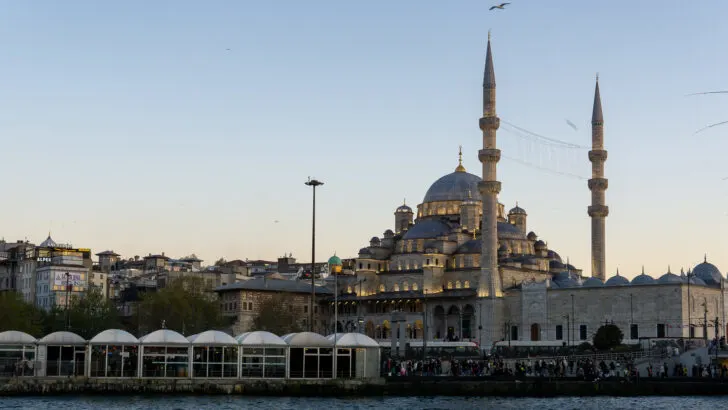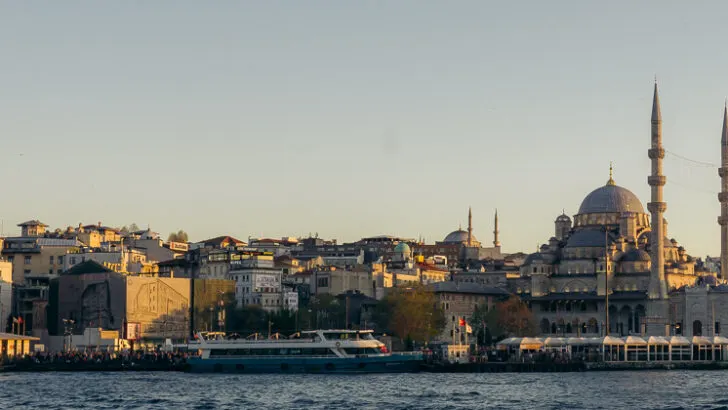Once known as the mighty Ottoman Empire, Turkey is now a cultural hotspot that deftly blends intercontinental flavours into all aspects of life.
In central Turkey, mountains explode out of picturesque landscapes, whilst deserts spread for miles all around creating a juxtaposition with the postcard-perfect beaches that outline the coast.
Packed full with deep and intriguing history, expect to find reconstructed ruins from thousands of years ago, spanning numerous civilizations and some of the world’s most powerful empires.
The food is tasty and plentiful, with a kebab shop on every corner or a vendor selling sweets such as baklava and Turkish delights.
Turkey is a truly incredible holiday destination! We’ve put together this guide to help you plan and get the most out of your trip, so read on for everything you need to know.
Turkey Travel Guides
This travel guide is designed to be an overview and is your ideal starting point for planning the perfect trip to Turkey. As you delve deeper into this stunning country, you’ll want to explore some of these in-depth guides (below) on specific cities or other important aspects of travel in Turkey.
Best Tourist Sim Cards in Turkey in 2024
The Ultimate 2 Week Turkey Itinerary in 2024
The Perfect Turkey Itinerary
After spending weeks exploring Turkey, we’ve put together what we consider the perfect itinerary for travelling Turkey. It is designed in a way that enables you to add or remove any places that are interesting to you, whilst staying within the number of days you have personally allocated to Turkey.
Turkey is surprisingly large and there is no shortage of places to see, but we consider Istanbul and Cappadocia to be must-dos for anyone visiting. Istanbul is a huge city and we recommend giving it as much time as possible. Cappadocia is small but one of the most unique places we’ve ever visited. The catch is it’s over 700km away from Istanbul so you’ll want to allow time to get there (usually 12 hours by bus each way).
Taking into account geographic proximity and the number of things to do in each location, here is our recommended guide:
3 days: Istanbul (must-do)
+3 days: Cappadocia (must-do)
+2 days: Antalya
+1 day: Kas
+1 day: Fethiye
+0.5 day: Pamukkale
+2 days: Selcuk (Ephesus)
+2 days: Cannakale (Gallipoli)
This is the standard route and what we recommend to most first-timers, however, it still misses a LOT. In fact, it misses half of the entire country. If you have extra time, consider exploring Ankara (the capital), Uzungol, Lake Van, Trabzon, Karz, Gaziantep, Adana and Mount Nemrut.
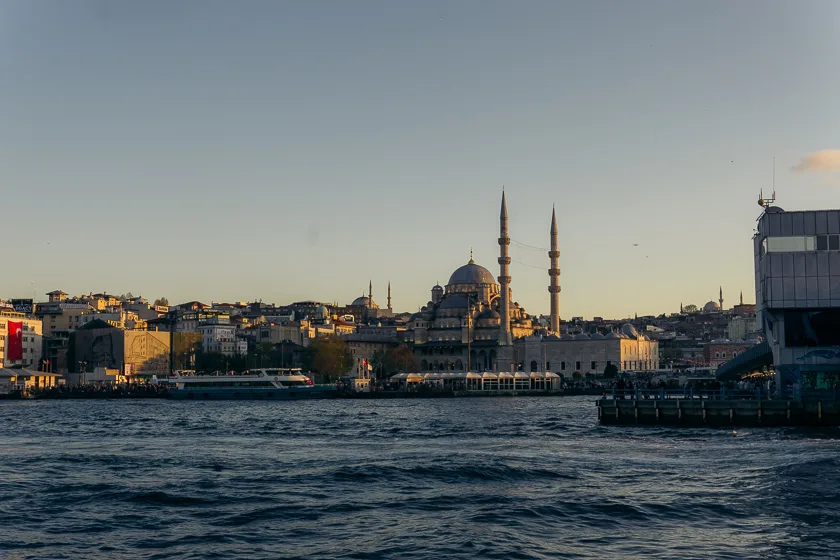
If you like to travel at a slower pace, we’d add extra days into the itinerary above. 3 days is ‘enough’ in Istanbul, but we’d recommend 5. No one would complain about spending too long in Cappadocia and extra time at the beaches around Kas and Fethiye would be great for relaxation.
If you only have a week in Turkey, go with 4 days in Istanbul and 3 days in Cappadocia.
Top Travel Tip!
We’ve been using Wise travel card to pay for EVERYTHING while we travel all around the world! Trust me, it’s better than your bank card and it costs less than $10 then it’s free forever.
Things to Do in Turkey
There are quite literally thousands of things to do in Turkey. Foodies should seek out delicious foods such as baklava, pide and doner, adventure seekers can paraglide over Fethiye, history geeks will love pretty much everything in Turkey and everyone else will enjoy being whisked away in the mosques of Istanbul and the unique landscapes of Cappadocia.
Part of planning any trip is knowing the most popular, absolute must-dos of any destination. These are our top 10 things to do in Turkey.
1. Hagia Sophia
Almost 1500 years old, the Hagia Sophia is likely to be one of the coolest man-made constructions you’ll ever set foot in. It has a detailed and rich history, including being rebuilt three times with the current structure originally built as a church and later converted into a mosque, a museum and back into a mosque again.
I can’t go into the history in detail so I’d recommend reading the Hagia sophia Wikipedia page before you visit and I’ll let the photos show the true grandeur of this wonder.
Tip: Since its status changed back to being a mosque entrance to the Hagia Sophia is free, however, the lines can be long so consider lining up before 8:30am.
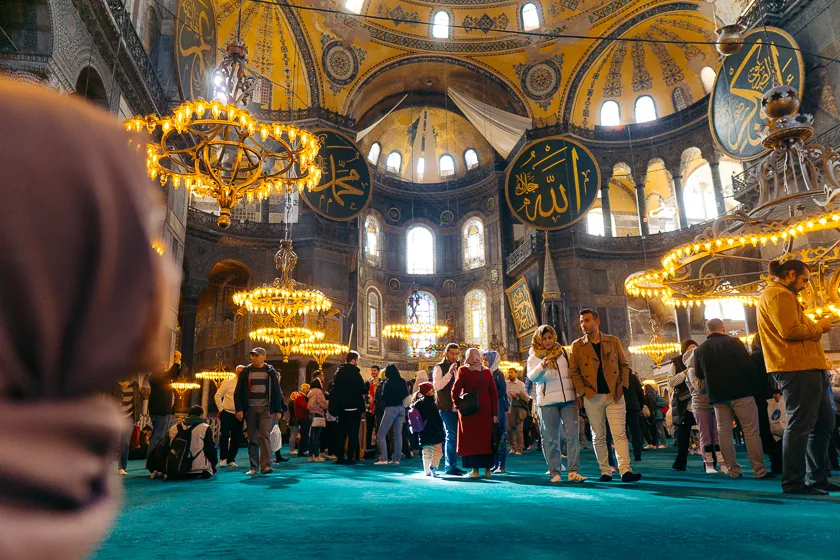
2. Ephesus Ancient City
During much of the reign of the Roman Empire, Ephesus, or Efes, was the second largest city with an estimated 250,000 citizens. Construction of Ephesus began around 1,000 BC, 3,000 years ago, but was rediscovered by an archeologist during the 19th Century and restoration has continued through the late 20th Century.
It’s hard to describe how incredible this place is and we consider it an absolute must-do for anyone visiting Turkey. It is one of the best restored examples of an ancient city anywhere in the world.
Tip: Skip the audio tour and download Rick Steve’s Ephesus Audio Tour (I also recommend his app) instead. Also, make sure to buy the pass that includes the terraced houses, St John’s Basilica and the Ephesus Museum.
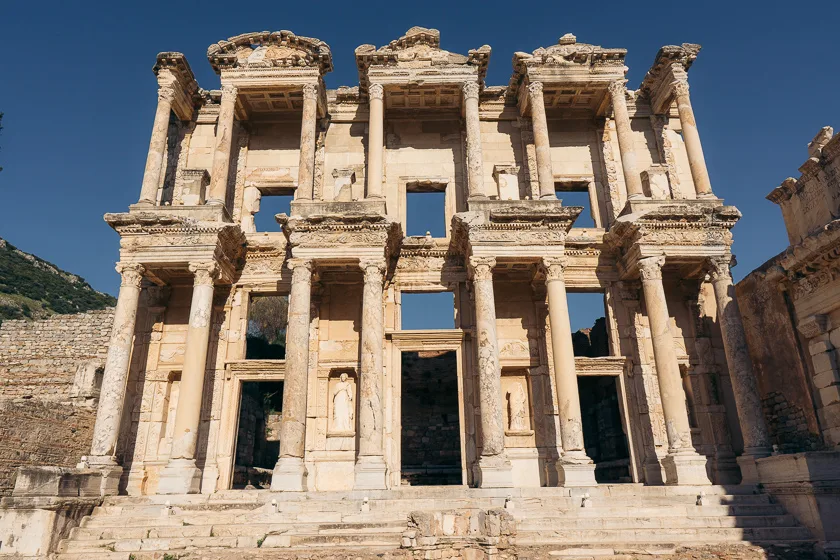
3. Goreme National Park
Goreme National Park, within the region known as Cappadocia, is undoubtedly one of the best places to visit in Turkey. There is a huge selection of activities ranging from hot air ballooning to underground cities, however, the park itself is really the highlight. Nature has created stunning rock formations and unique landscapes that can’t be found anywhere else in the world.
We recommend exploring the region over two full days with the ‘Red Tour’ and ‘Green Tour’. We compared the price of renting a car and self-driving and found for 2 people it’s basically the same price to do the tours. You lose some freedom but you save a lot of stress and gain a tour guide so it’s really the best way to explore the park.
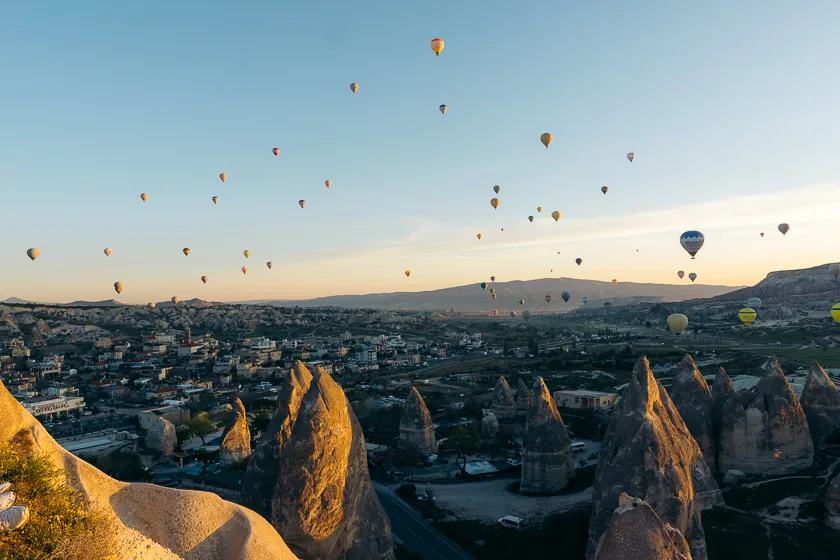
4. Topkapi Palace
There are two palaces in Istanbul, Topkapi Palace and Dolmabahce Palace. Both are stunning with the latter being the more recent one built by Sultan Abdulmecid in 1856. If you have the time (and money) both are worth doing, but if you can only do one then we highly recommend Topkapi Palace.
This palace illustrates the architecture and imperial lifestyle over 400 years of the Ottoman Empire. It is now more of a museum than a palace with rooms all around the grounds showing off various elements of life over the centuries, ranging from clothing to cooking.
Tip: The entrance fees are quite expensive at around 33 EUR but are 100% worth paying. The audio guide is included but make sure to purchase entrance to the harem – this place is genuinely incredible and you will not be disappointed.
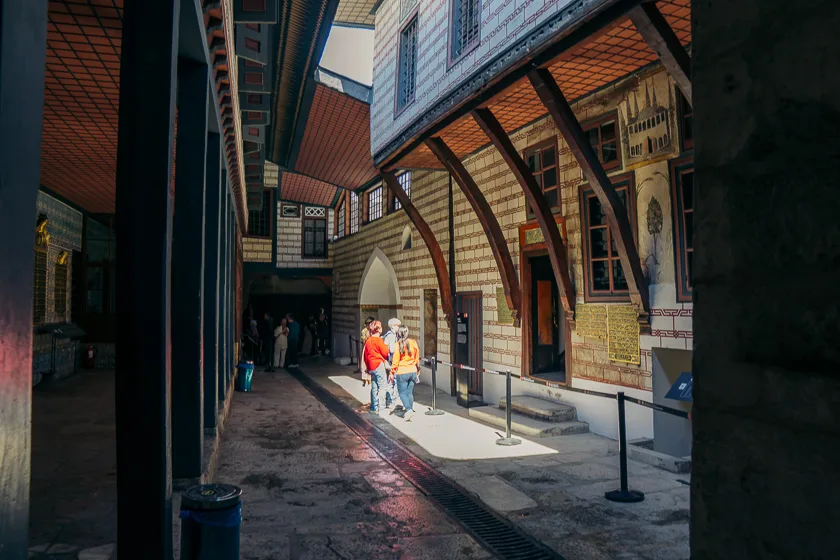
5. Hot Air Ballooning in Cappadocia
Hot air ballooning in Cappadocia is one of those bucket list experiences. Sure, it doesn’t portray thousands of years of history like some of the other experiences in Turkey, but the sheer beauty of the region cannot be better viewed than from the sky during sunrise.
Your best bet is to book this Hot Air Balloon tour by Royal Balloon via Get Your Guide. They are fully certified and the best in Cappadocia.
Tip: Book the tour on your first day in Cappadocia and allow at least one, ideally two, back up days in case the tour is postponed due to bad weather (it happens often). If you’re backpacking then this experience likely won’t fit your budget. Head out onto your hotel balcony or hike to one of the viewpoints near Goreme to watch the hot air balloons instead.
6. Mount Nemrut
This UNESCO world heritage site is a famous peak in Turkey known for its large number of statues. This unique attraction is a little off the typical tourist path through Turkey and for this reason we don’t recommend it for most travellers, but if you’re the more adventurous type it’s worth ticking off.
The easiest option is to book a tour departing from your previous stop which is most likely Goreme. You can also DIY your own visit by staying in Karadut.
7. Pamukkale & Hierapolis
Pamukkale is a town located just a few hours from Selcuk. Naturally occurring geothermal activity combined with calcium formations caused hot pools to form here which were first discovered around 2,000 years ago. The ancient city of Hierapolis was eventually constructed by the Greek Empire next to these hot springs.
The Pamukkale pools and travertines are now empty with just a handful of man-made pools remaining with water in them. Any photos you see on the internet should be ignored as the place looks nothing like this anymore. That said, you can still visit and imagine how impressive they once were.
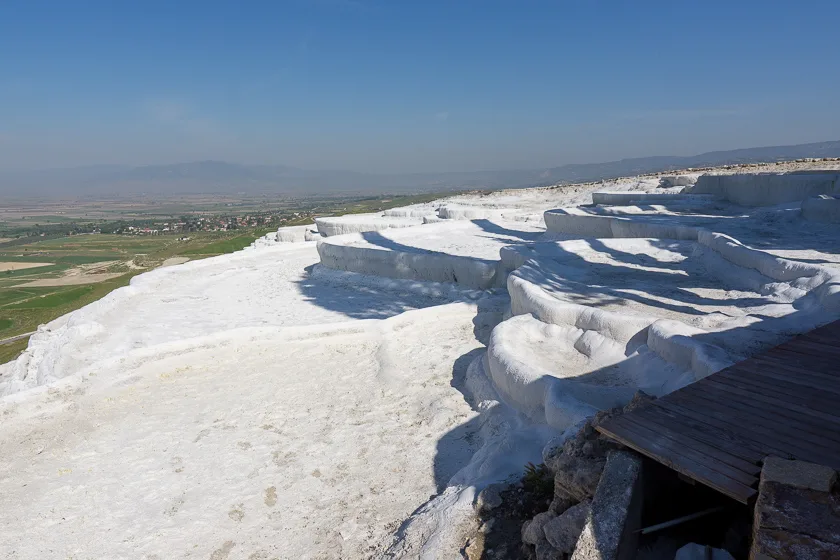
The ancient city of Hierapolis was, at least for us, the highlight of visiting Pamukkale and the reason we chose to still include it in one of the best things to do in Turkey. Not quite as well restored as Ephesus, the ruins of Hierapolis are slowly being uncovered and the theatre is one of the best examples of an ancient Greek theatre in the world.
Tip: We chose to spend a night here, but there really is nothing else to do in the town. It would work out cheaper and easier to just book this tour departing from Antalya or this one departing from Selcuk / Kusadasi / Izmir.
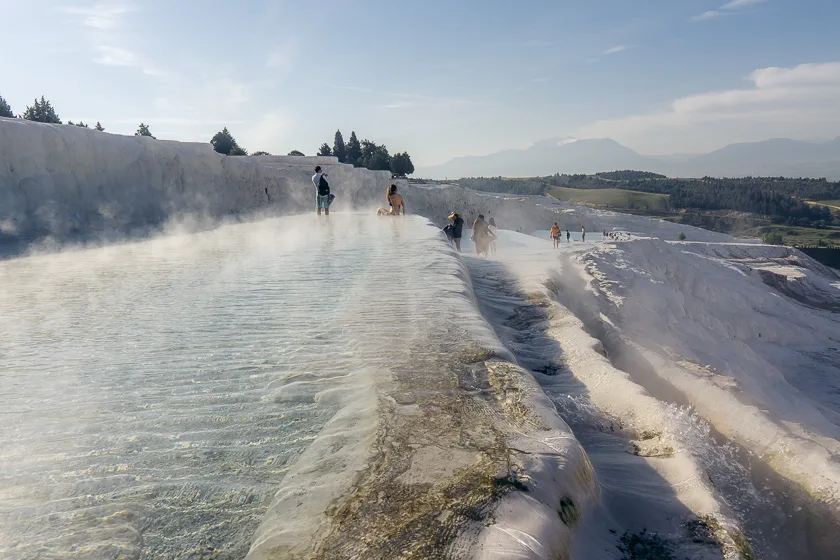
8. Tour Gallipoli
Gallipoli was the landing site of the ANZAC soldiers during WWI. As New Zealanders ourselves, this location holds a lot of significance as it is the place where many of our ancestors were lost fighting for our freedom. For the Turkish people, this location is the key to conquering Istanbul and their successful defense of this small piece of land meant the survival of Turkey as we know it today.
For Australians and New Zealanders, staying a couple of nights in Canakkale and booking a tour is a must-do experience. It’s also an interesting part of WWI history to learn about for any other visitors.
We took this exact tour from Canakkale to Gallipoli by Crowded House Tours and it was fantastic. The guide was awesome, had 25 years of experience doing this tour and spoke really good English. You could tell he was extremely passionate about the area. This isn’t something you can do yourself as the sites would have no meaning without a guide and getting around would be nearly impossible.
Crowded House also has a tour including Troy and one departing from Istanbul (a very long day but worth it).
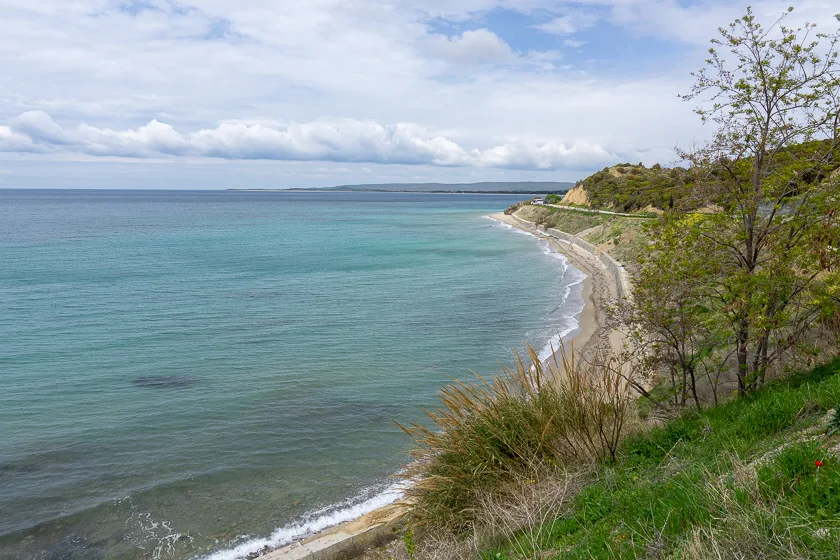
9. Blue Mosque
The Blue Mosque is one of the most important mosques in Istanbul and its beautiful, blue-tiled interior attracts large numbers of tourists every single day. We preferred the Hagia Sophia and the thousands of years of history packed into it, but the more modern Blue Mosque is extravagant and gorgeous in its own right. Allow half an hour to visit and sit down on the carpet.
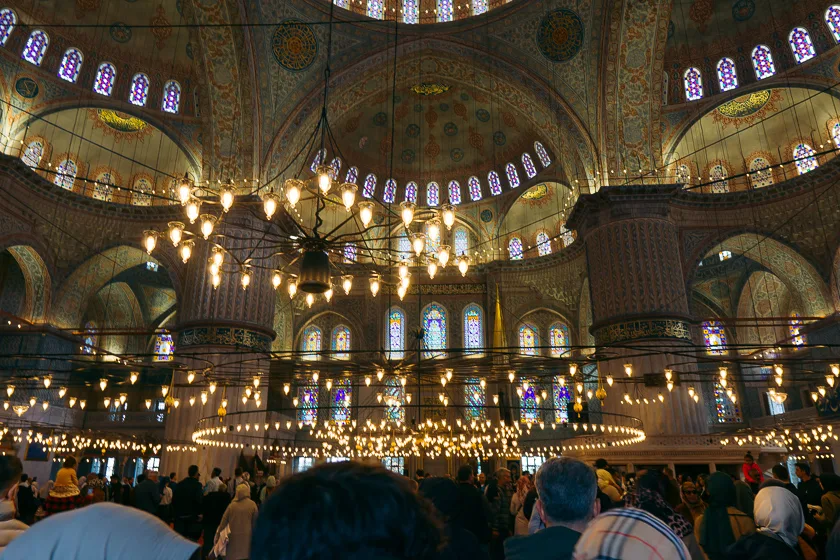
10. Oludeniz Beach
To round out this list we feel like visiting the beaches along Turkey’s southern coast are a great way to spend a few days. Picking one spot is challenging and we’d recommend doing a roadtrip through the entire region, but Oludeniz is one beach that is particularly popular and picturesque. We’d recommend spending a day here relaxing and exploring whilst staying in nearby Fethiye.
Turkey Accommodation
There’s no shortage of good and bad accommodation in Turkey but it all ranges in quality and value. Of course, we haven’t stayed in every hostel, hotel and guest house in Turkey, but here are a few of our favourites that we’ve either personally stayed in or heard great things about from other travellers.
Istanbul
Budget & Mid-Range: Archeo – they have a fantastic cafe downstairs to chill in and nice rooms, perfectly located in Karakoy near the tram to Sultanahmet.
Luxury: Wings Hotel – an upper mid-range to luxury hotel located right in the heart of Karakoy with all the best amenities you’d expect.
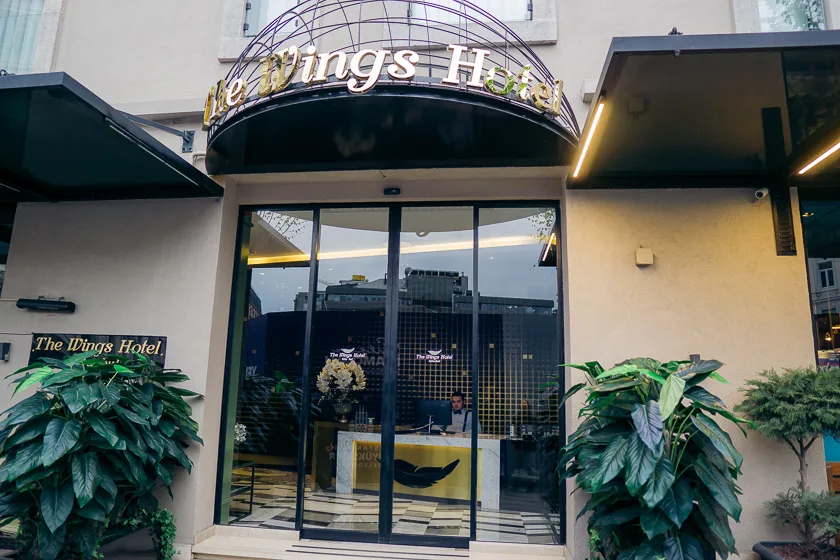
Selcuk
Budget & Mid-Range: ANZ Guesthouse – Owned by an Aussie named Harry, ANZ Guesthouse is the most homely and wholesome place you can stay in Selcuk – plus it has free breakfast.
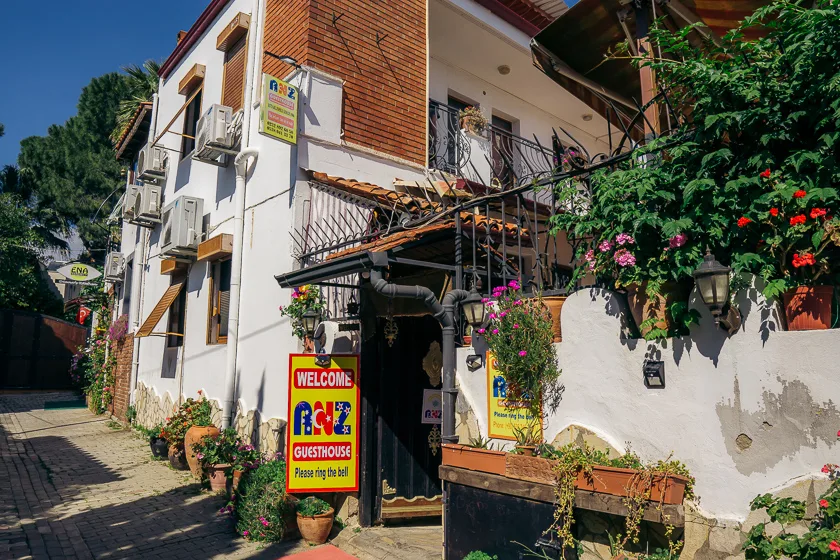
Pamukkale
Budget: Hotel Pamukkale – Perfect location and really nice rooms for cheap, you can’t fault it. Tikir Grill House is just down the road which is our favourite restaurant in Pamukkale.
Cappadocia / Goreme
Budget & Mid-Range: Arch Palace Cappadocia – If you’re on a budget, this is the best place you can stay in Cappadocia. Although not as ‘cavey’ as the more expensive options, the rooms here are really cool and the rooftop has an incredible view.
Turkey Travel Tips
- Book your accommodation before you arrive in Turkey. Booking.com will not allow you to book accommodation in Turkey once you are here, you must do it outside the country.
- If your phone supports eSims, buy your sim card online here with Airalo. Sim cards in Turkey require a passport and the operators act like a Duopoly to effectively scam tourists. It is also time consuming to get a card as the process takes a bit of time. Sim cards in Istanbul cost around 41 USD but you can buy one with Airalo for around 12 USD instead.
- The best way to get around Turkey is by bus. The largest operator, Kamil Koc, was recently bought by Flix Bus and can now be booked on their English site here. The second best way to explore Turkey is with a rental car, but bear in mind the drivers here are a bit crazy and the distances can be very far.
- The Turkish Lira has hit around 80% annual inflation. That means all the prices you see online are out of date in a matter of weeks. We’ve made the decision to include all prices for our Turkey guides in USD for this reason.
- If you don’t already have one, get a Wise Card to use when buying things or withdrawing cash in Turkey.
- Use Uber and BiTaksi apps to book taxis and avoid being ripped off. If you get one off the street, ensure they run the meter or refuse to go with them.
- The language barrier can be a shock as most people do not speak any English in Turkey.
- Don’t forget to get a visa. Some countries are exempt but most (including US and Australia) will require an eVisa.
- Females, you will require a head scarf to visit the mosques. Buying it in shops around Sultanahmet is overpriced. Instead, you can buy a nice one for around $3 USD just past the security stop for Hagia Sophia.
- Get an Istanbulkart to use the public transport in Istanbul.
- Ziraat Bankasi is the only ATM that we have consistently found to have no withdrawal fees. We recommend looking for these. If you need to use another ATM, just make sure you use a bank ATM in a safe area. The ATM will tell you if there are any fees before you complete your transaction and you can cancel and try another ATM if you are unhappy with the fee. Always decline ‘currency conversion’ if it asks you.
- Set your expectations low for Pamukkale. It is still incredible, but it is nothing like the photos.
- Always keep a couple of lira in coins in your pocket to access the bathrooms.
Best Time to Visit Turkey
The best time to visit Turkey is during the shoulder months of April, May, September and October. Temperatures during summer can easily reach 40 degrees whilst winter in some places can drop below 0.
During the shoulder months, temperatures are moderate in all areas of the country and the crowds tend to be far more manageable.
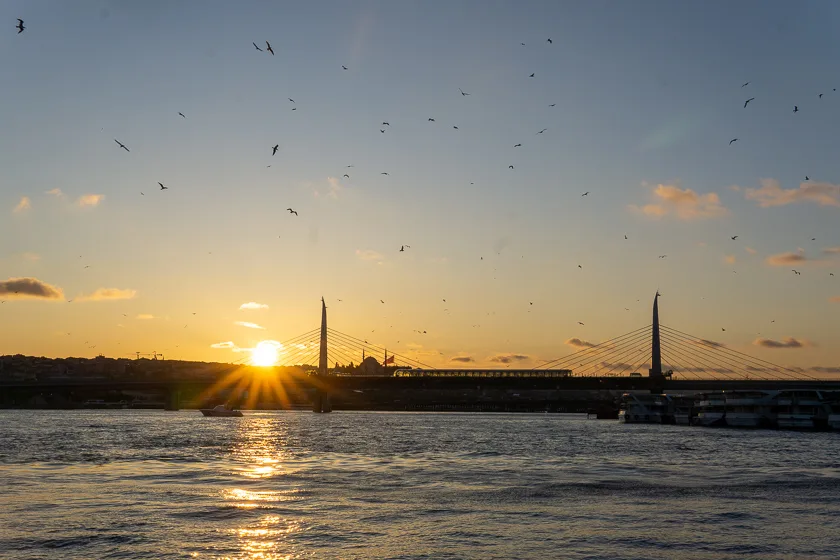
Getting Around Turkey
Getting around Turkey can sound daunting at first, but it’s actually quite simple and effective. All the usual forms of transport exist, however, by far the most common option is to bus. Sometimes things don’t go as planned when taking transport in Turkey, so it is best to go with the flow and do your best to end up in the right place – it pretty much always works out!
Buses
Buses are the transport of choice for most locals and are the best way to get around the country for travellers. There are a few common brands such as Pamukkale, Metro Turizm and Kamil Koc.
They are all much the same, however, Metro Turizm has a bit of a poorer reputation whilst Kamil Koc (now Flix Bus) is the market leader with a very strong track record. Every time we’ve travelled with Kamil Koc things have gone smoothly and the buses have been amazing.
Now, about the buses in turkey. For some reason, they have some of the nicest buses we’ve travelled on in the whole world. Usually, the on-bus staff will come down throughout the trip to hand out snacks and drinks (like you’d expect on a flight). Except it’s far more comfortable than a flight, with plenty of leg room and large, plush seats.
The one thing I’d like to point out is that the staff on the buses barely ever speak any English. At all. This makes it hard to know when you are at a toilet stop or just picking up passengers for 30-seconds. It means they can’t/won’t always tell you when you need to change buses or shift your bags. You just need to remain diligent and persistently ask questions to ensure you don’t miss something. Waving your ticket in front of the attendant or repeating your destination has worked plenty of times for us.
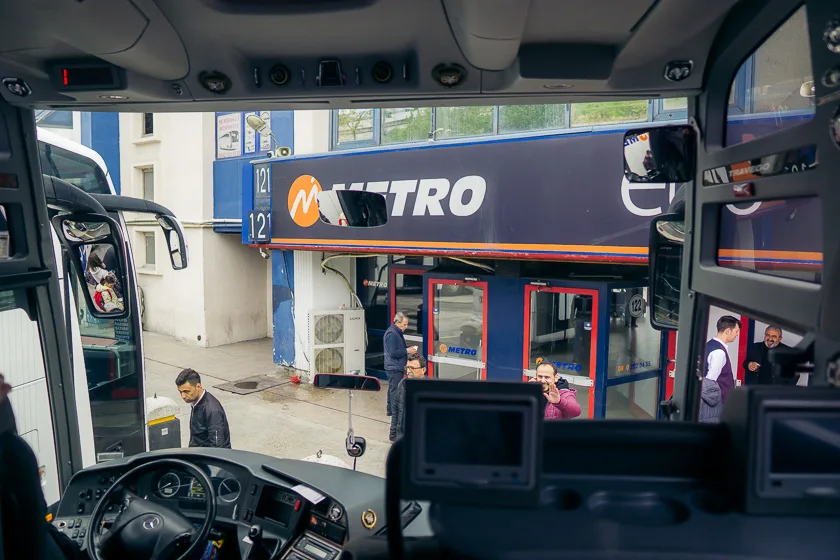
Night Buses
Night buses are a popular way to travel in Turkey, especially when you wish to cover large distances. There are numerous routes connecting Goreme, Izmir, Antalya and Istanbul via night buses and we consider this to be the best way to travel when the trip is longer than 7-8 hours.
The buses are surprisingly comfortable and unless you struggle sleeping normally then you should be able to get some sleep. For the routes connecting Cappadocia, you’ll save on a night’s accommodation whilst freeing up a day for sightseeing.
Flights
Flights are common in Turkey but the prices are higher than other modes of transport. If money is no object but you’re limited on time, then we’d recommend considering flights for the longer sections of your trip, such as Istanbul to Cappadocia.
Turkish Airways is the premium airline in Turkey and we found them fantastic to fly with, equal to other premium airlines around the world.
Pegasus is the budget airline. We haven’t yet flown with them, but from what we can tell they are fairly similar to other budget airlines such as RyanAir or Vueling in Europe (though we hope they might be slightly better!).
Flying always comes with more hassle than buses or trains anywhere in the world, but Istanbul airport is particularly far away from the city center so make sure to allow 1.5 – 2 hours extra in case the traffic is really bad.
Trains
Why take a bus when you can sit on a nice air-conditioned train? Well, this typically holds true and trains are absolutely an option in Turkey. They don’t cover nearly as many routes as the buses and Seat61 covers them all perfectly here.
Personally, the train route from Selcuk to Denizli is a must for most travellers as it’s cheaper and just as fast as the bus. We haven’t come across any other times where we’ve chosen the train over the bus in Turkey.
Rental Cars
Renting a car in Turkey is a great way to see all the sights. There are a handful of historic sights around Pamukkale, Selcuk and Antalya that are really best visited by car. Similarly, beach-hopping along the coastal towns of Kas, Fethiye and Antalya is always better when you have the freedom to explore at your own pace.
Remember Turkey drives on the right-hand side of the road and that the road rules here appear to act more like guidelines to other road users. You’ll also want to be a very confident driver before tackling the roads in Turkey.
The major cities, especially Istanbul, tend to consist of millions of tiny roads and they’re all packed with crazy drivers. If you are renting a car in Turkey, we recommend picking it up when you leave Istanbul and returning it when you arrive.
In terms of where to book a car, Discover Cars is your best bet here. We’ve heard the occasional story of dodgy rental car companies so we recommend checking the reviews of who you’re booking on an aggregator website, such as Discover Cars, and booking on the platform.
Full insurance will give you peace of mind, but make sure to also read your travel insurance policy as these often cover your rental car excess. A lot of people end up buying insurance that they don’t even need.
Food & Restaurants in Turkey
The food in Turkey is out of this world. It is packed with flavour, fresh, and typically very cheap. There are plenty of the usual culprits that you’ll want to check out, such as kebabs and baklava, then there are some new things you’ll want to try such as helva, borek and pide. Here’s our quick guide.
Doner Kebap & Durum
Kebap generally refers to any cooked skewered meat. Some places will serve individual skewers, whilst others will cook a huge lump of meat on a spit slowly for hours before slicing off pieces. This meat is usually served in a delicious wrap (durum), sandwich (ekmek) or with a plate of sides including salad, chips and rice.
Balik Ekmek and Balik Durum
Balik refers to fish and I am mentioning it specifically in this article as fish sandwiches, or balik ekmek, are exceptionally famous to try in Istanbul. Head down to the water and seek out the men cooking fish over coals. Our favourite spot is located in Karakoy here, however, you can also get delicious balik over on the Eminonu side under the Galata bridge.
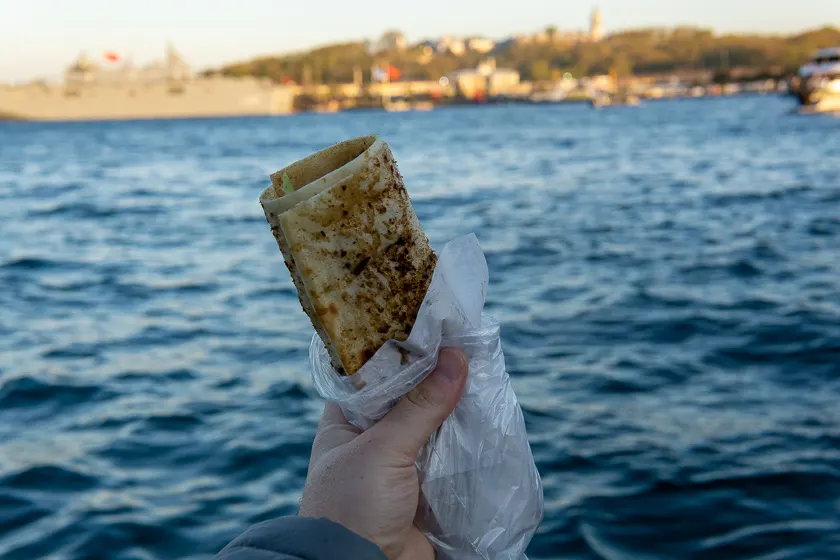
Pide
Pide is essentially Turkish pizza. It is a soft and fluffy dough that is shaped into a circle then cooked. The best pide and lahmacun is cooked in a woodfired oven to give it a charred flavour and crunch whilst maintaining its fluffy interior. They can be ordered plain, but it is best to get one with toppings. Mince is the most popular.
Lahmacun is similar but the edges are not rolled up and, so I’ve heard, the mince topping is different. It is best eaten with a bunch of greens in the middle and rolled up like a durum.
Lahmacun Pie in Our Region is our favourite place in Istanbul.
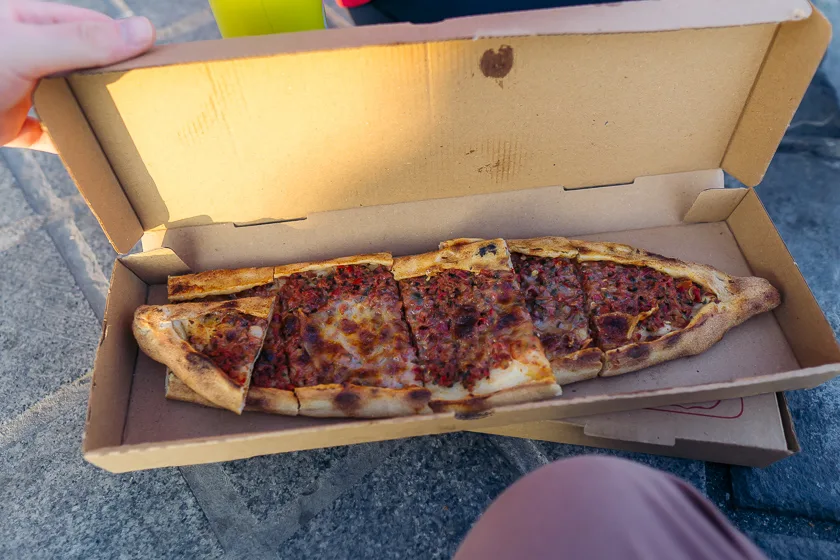
Kofte
Kofte are meatballs made out of minced meat and spices. They can often be sold by themselves, in a soup or on a plate with other meats and vegetables. Our favourite is the spicy Izmir kofte which is a sort of spicy soup with meatballs and potatoes.
The best kofte we’ve had was from a small lokantasi in Sultanahmet called Sulemaniye Lokantasi (and it was super cheap)
Baklava
Baklava is truly heaven. Little more needs to be said. Layers upon layers of thin pastry drenched in syrup or sweet milk and a paste made with various flavours such as pistachio and walnut. Try it at Gulluoglu in Karakoy.
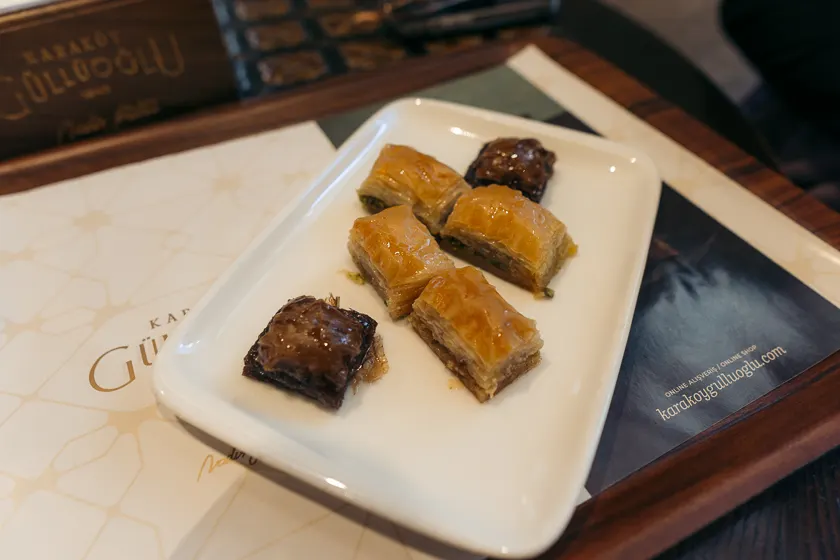
Borek
Borek and a cup of Cay (tea) is the best way to start each day in Turkey. Borek is essentially just layers of flaky pastry. Yes, it’s as delicious as it sounds. You can buy various flavours (cheese is very popular) but my favourite for breakfast is plain (sade borek) with a sprinkling of sugar.
Honestly, borek is sold everywhere in the mornings and you probably won’t be able to find a bad place. Just go somewhere near where you are staying.
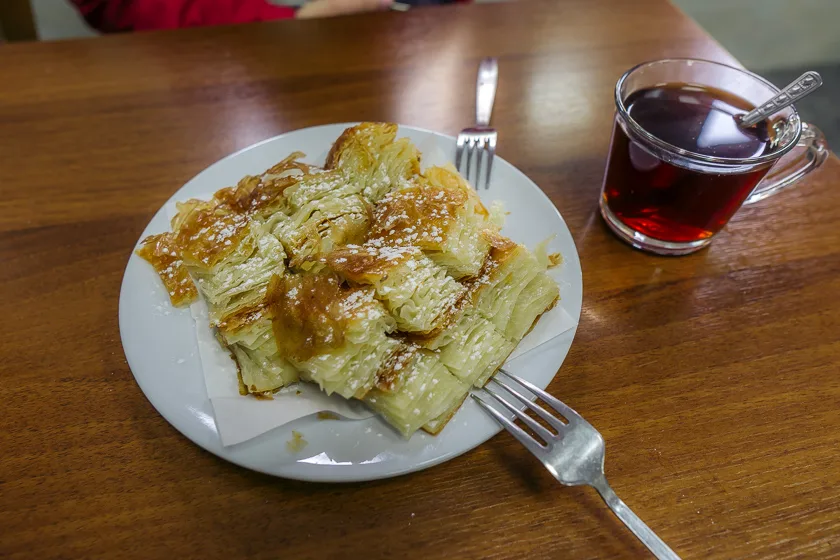
Turkish Delight
The most famous sweet in Turkey, Turkish Delights are moreish cubes of flavoured gummy…stuff. I don’t know what it’s made of, but I know it’s delightful.
You have two approaches here. Option one is to seek out the best turkish delights in which case you’ll head to Hacı Bekir in Eminonu or Karakoy and pay around $10 USD for a 250g box. Or option two, find any place you can and buy it. Option two should be a lot cheaper, we’ve seen it as low as about $10 USD per kg.
The only thing I’d suggest is avoiding the tourist traps such as the Spice Market and Grand Bazaar.
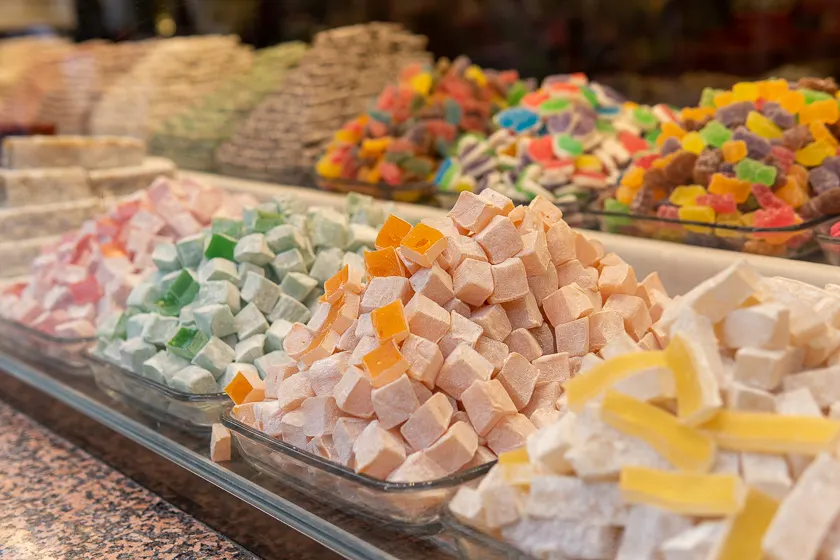
Halva
Lastly, halva is a bit of a weird treat in Turkey in that it varies so much. It’s worth trying a few when you get the chance. It is usually sold as a paste kind of like ice cream.
However, we more commonly found a treat which is made out of cheese and is baked like a cake. Served hot with sherbet and ice cream, this halva is unbeatable.
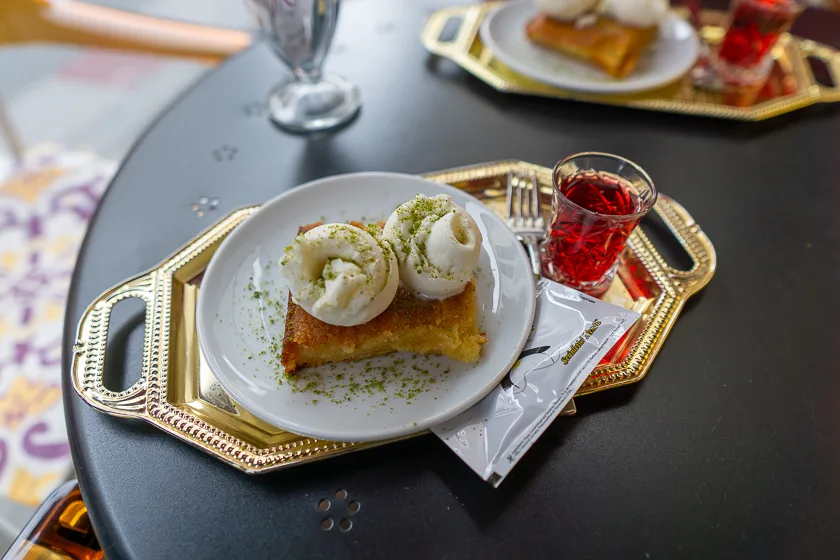
Travel Information
Currency: Turkish Lira (TRY)
Electricity Socket: 220V AC electricity using a standard Europe Type C plug (two prongs)
Turkey Visa: Many countries do not require a visa to visit Turkey whilst many do. You should find your country on the official page here to find out what you require. If you require one, an evisa is usually the best option.
Safety: We’ve found Turkey to be a very safe country, however, this is only if you stick to our recommended itinerary above. There are regions that should be avoided, in particular along the border with Syria. Check out your local travel advisory before visiting, such as the US one here.
Language: Turkish is the official language spoken in Turkey. It is helpful to know how to say hello, ‘mehraba’, and thank you, ‘tesukkurler’. Hardly anyone in Turkey speaks English, even in tourist areas.
Turkish Capital: The capital of Turkey is Ankara, however, a lot of travellers choose to skip this city.
Water: It is safest to purchase and consumer bottled water, otherwise, ensure you boil any tap water before drinking.
Banks & ATMs: You’ll find many banks and ATMs around Turkey. Most of them are fine to use, but if you wish to avoid fees then we recommend withdrawing cash from Ziraat Bankasi ATMs. These are found commonly all around the country and we’ve never been charged a withdrawal fee.
The best card to use when travelling is the Wise Card. This card has the lowest conversion fees of any we’ve found and it’s been our main card for years.
Sim Cards: Sim Cards are the biggest scam you’re likely to come across in Turkey. If you have a new phone you should use an esim such as Airalo. This will be the cheapest and easiest (trust me, it’s easier than it looks) option in Turkey. Check it out here. Also check out our detailed guide to tourist sim cards in Turkey.
If your phone doesn’t support esims, then you will need to go with Turkcell, Vodafone or Turk Telekom. Of the three, Turkcell and Vodafone offer the best coverage.
All three require a passport to purchase a sim card and must be done in-store. You will be forced to purchase a tourist sim for around 28 EUR (TRY equivalent).
Tipping: Tipping isn’t common or expected in Turkey, but it can be nice to do in restaurants where you experience good service. You don’t typically tip the owner of a shop.


